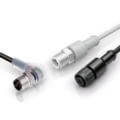While 5G technology is undoubtedly improving global connectivity capabilities, it has led to challenges for telecoms equipment manufacturers because of the demands imposed by its operation. For example, the frequencies used with 5G raise to much higher than with 4G and those signals cannot easily penetrate some materials and can be easily obstructed, which has led to signal attenuation issues. Here Juha Pesonen, segment leader for telecommunications at global composites manufacturer Exel Composites, discusses how to strike a balance between mechanical strength and signal permittivity for 5G radomes manufactured using composites.
The value of 5G stems from the fact that it can operate at higher frequencies than its predecessors, facilitating peak data rates of up to 10 Gbps and the ability to handle up to 10,000 times more traffic than previous networks. However, installing 5G networks is not cheap, with significant investment needed in upgrading infrastructure to accommodate them. Because the 5G band extends to the less crowded higher frequency spectrum, between 1GHz to 6 GHz — or by using millimeter waves on new radio frequencies anywhere above 24 GHz — it can easily be blocked by obstacles, such as buildings and trees, and it can even be disrupted by rain or humidity.
Radomes are a key part of telecommunications infrastructure, covering antenna systems equipment to protect them from the environment, but their use in 5G networks has posed challenges in material choice to not obstruct 5G communications. To accommodate this, radomes for high frequency networks must be manufactured using lower attenuating materials that can be penetrated by the higher frequency signals.
Composite radomes for 5G networks
The fundamental challenge for making radomes suitable for 5G networks is striking the right balance between having the required mechanical properties to provide ongoing protection for the system with the desired signal permittivity. While composites such as fiberglass have been previously used successfully for 2G, 3G, and 4G radomes, the same composite construction will not be optimal with the higher frequency systems.
To overcome the challenge of material choice for 5G radomes, Exel Composites recently secured a patent for its new 5G macro and MIMO base station radome design, incorporating a honeycomb core into thin fiberglass walls. This process enables a signal window to be manufactured in the radome structure, balancing the mechanical requirements with cost-efficient continuous pultrusion manufacturing. The combination of fiber type, resin, and signal window size and location can be tailored to enhance specific properties depending on the application. For example, the design can be tailored to improve mechanical strength or boost signal permittivity in required areas depending on the environment the radome is situated in.
Continuous manufacturing processes such as pultrusion are designed for high volume production to specific specifications at consistently high-quality levels, ensuring the delivery of robust, reliable, and cost-effective composite solutions. Other manufacturing processes, involving more manual steps, make it more difficult and more costly to manufacture structures in large volumes, and they don’t have the same levels of repeatability as continuous manufacturing processes. For this reason, pultrusion is an ideal choice of manufacturing process for composites in 5G applications where quality and cost-effectiveness are of the upmost importance.
Ultimately, with radomes for 5G applications, it all comes down to the balance between mechanical and electrical properties. Navigating this might seem like a daunting process, but the challenge can be overcome by consulting a knowledgeable partner who understands all the different considerations and can suggest the most suitable solution available. For example, Exel Composites has the expertise and manufacturing capabilities to guide customers through the process and produce the most suitable composite solution for a given application.
To learn more about Exel Composites’ telecommunications solutions, visit the website today: https://exelcomposites.com/composite-solutions/composites-for-telecommunications.








